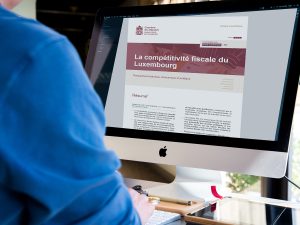On 23 September 2025 the Scientific Unit of the Chamber of Deputies released a 128 page study exploring Luxembourg’s tax competitiveness. The report explains how multinational enterprises have historically paid much less than the statutory corporate tax rate—only about 0.9 percent in some estimates—even though the headline rate exceeded 29 percent. The multidisciplinary study was produced by a multidisciplinary team from the Scientific Unit that included geographer Estelle Mennicken, tax jurist Julie Kaprielian, historian Fabio Spirinelli and two researchers from the University of Luxembourg, Nora Paulus and Benoît Majerus.
The report’s fourth chapter offers a critical history of the Grand Duchy’s financial centre and was co written by Benoît Majerus. The chapter reframes the master narrative of Luxembourg’s success by showing how fiscal sovereignty has been constructed over nearly a century and how it has adapted to changing international norm.
The historical chapter traces Luxembourg’s fiscal competitiveness back to 1929, when steel giant ARBED (today ArcelorMittal) promoted a law creating a special regime for holding companies. Intended to protect local capital from foreign takeovers, the law granted tax exemptions to companies holding participations and, according to contemporary socialist deputy René Blum, effectively created a fiscal immunity that introduced a form of capitalist feudalism. Despite these critiques, the regime quickly succeeded, enabling banks, notaries and lawyers to establish thousands of holding companies and making Luxembourg a leading hub for tax planning. The chapter emphasises that predictability and legal flexibility, rather than unusually low rates, formed the core of Luxembourg’s strategy.
In the post‑war period the holding law’s tax advantages were extended to investment funds, which catalysed a new industry but also led to controversy when the Luxembourg‑registered funds of the Investors Overseas Service (IOS) collapsed in the early 1970s. Luxembourg then shifted its focus to the Euromarket; thanks to relaxed banking regulations and favourable listing conditions, the number of foreign banks in the Grand Duchy grew from seven to ninety‑six between 1966 and 1979. The financial centre diversified further as domiciliation became a lucrative business for fiduciary firms and law offices, and by the 1980s private banking emerged to serve a middle‑class international clientele—epitomised by the “Belgian dentist” who sought to shelter savings from home‑country taxation. Banking secrecy, implicitly marketed since the interwar period, was formally codified only in 1981, and the study shows how these developments together forged a complex financial ecosystem.
The report underscores the reputational risks associated with this model. Scandals such as IOS, Banco Ambrosiano, BCCI, LuxLeaks and the Panama Papers have repeatedly cast the financial centre in an unfavourable light, reinforcing foreign perceptions that Luxembourg’s arrangements undermine other states’ tax bases. The historical analysis also highlights the practice of “negotiated fiscality”, whereby personalised tax rulings and exemptions were offered outside clear legal frameworks, potentially violating equality before the law. While Luxembourg never relied exclusively on low tax rates, the combination of predictable laws, bespoke rulings and a cooperative public–private network proved highly attractive to multinational groups. This approach, however, also led to criticisms that profit shifting via Luxembourg deprives neighbouring countries of revenue and erodes trust.
